Design of Distributed Bragg Reflectors for Green Light-Emitting Devices Based on Quantum Dots as Emission Layer
Abstract
:1. Introduction
2. Theoretical Analysis
2.1. Distributed Bragg Reflector
2.2. Cavity Emission Characteristics
Multilayer Calculation
2.3. Quantum Dot Emission
3. Results and Discussion
4. Conclusions
Author Contributions
Funding
Informed Consent Statement
Data Availability Statement
Conflicts of Interest
References
- Melville, J.; Kapelewski, M. Optical Properties of Quantum Dots; UC Berkeley College of Chemistry: Berkeley, CA, USA, 2015; pp. 2–3. [Google Scholar]
- Ibrahim, A.; El-Sayed, N.; Kaid, M.; Ashour, A. Structural and electrical properties of evaporated ZnTe thin films. Vacuum 2004, 75, 189–194. [Google Scholar] [CrossRef]
- Tsukuda, S.; Kita, M.; Omata, T. Zn (Te1 − xSex) quantum dots synthesized through a facile route and their band-edge and surface state driven visible-light emission. J. Lumin. 2021, 231, 117829. [Google Scholar] [CrossRef]
- Wageh, S. Ternary ZnS: Te nanoparticles capped with 3-mercaptopropionic acid prepared in aqueous media. J. Mater. Sci. Mater. Electron. 2016, 27, 10877–10887. [Google Scholar] [CrossRef]
- Chang, L.; Cheng, J.; Hsu, C.; Chao, H.; Li, W.; Chang, Y.; Chen, K.; Chen, Y.; Laing, C.-T. Isoelectronic centers and type-II quantum dots: Mechanisms for the green band emission in ZnSeTe alloy. J. Appl. Phys. 2009, 105, 113511. [Google Scholar] [CrossRef]
- Asano, H.; Arai, K.; Kita, M.; Omata, T. Synthesis of colloidal Zn (Te, Se) alloy quantum dots. Mater. Res. Express. 2017, 4, 106501. [Google Scholar] [CrossRef] [Green Version]
- Asano, H.; Tsukuda, S.; Kita, M.; Fujimoto, S.; Omata, T. Colloidal Zn (Te, Se)/ZnS core/shell quantum dots exhibiting narrow-band and green photoluminescence. ACS Omega 2018, 3, 6703–6709. [Google Scholar] [CrossRef] [PubMed] [Green Version]
- Asano, H.; Omata, T. Design of cadmium-free colloidal II–VI semiconductor quantum dots exhibiting RGB emission. AIP Adv. 2017, 7, 045309. [Google Scholar] [CrossRef] [Green Version]
- Patra, S.K.; Bhushan, B.; Priyam, A. Water-soluble, luminescent ZnTe quantum dots: Supersaturation-controlled synthesis and self-assembly into nanoballs, nanonecklaces and nanowires. Dalton Trans. 2016, 45, 3918–3926. [Google Scholar] [CrossRef] [PubMed]
- Adachi, S. Optical Constants of Crystalline and Amorphous Semiconductors. In Numerical Data and Graphical Information; Kluwer Academic Publishers: Boston, MA, USA, 1999. [Google Scholar]
- Zhang, H.; Su, Q.; Chen, S. Quantum-dot and organic hybrid tandem light-emitting diodes with multi-functionality of full-color-tunability and white-light-emission. Nat. Commun. 2020, 11, 1–8. [Google Scholar] [CrossRef] [PubMed]
- Wageh, S. Light emitting devices based on CdSe nanoparticles capped with mercaptoacetic acid. IEEE J. Quantum Electron. 2014, 50, 1–8. [Google Scholar] [CrossRef]
- Prontera, C.T.; Pugliese, M.; Giannuzzi, R.; Carallo, S.; Esposito, M.; Gigli, G.; Maiorano, V. Flexible distributed Bragg reflectors as optical outcouplers for OLEDs based on a polymeric anode. J. Inf. Disp. 2021, 22, 39–47. [Google Scholar] [CrossRef]
- Assafli, H.T.; Abdulhadi, A.H.; Nassir, W.Y. Design High Efficient Reflectivity of Distributed Bragg Reflectors. Iraqi J. Laser 2016, 15, 15–20. [Google Scholar]
- Dong, W.J.; Lo, N.-T.; Jung, G.H.; Ham, J.; Lee, J.-L. Efficiency enhancement and angle-dependent color change in see-through organic photovoltaics using distributed Bragg reflectors. Appl. Phys. Lett. 2016, 108, 103902. [Google Scholar] [CrossRef]
- Delbeke, D.; Bockstaele, R.; Bienstman, P.; Baets, R.; Benisty, H. High-efficiency semiconductor resonant-cavity light-emitting diodes: A review. IEEE J. Sel. Top. Quantum Electron. 2002, 8, 189–206. [Google Scholar] [CrossRef]
- Wu, Y.; Yang, J.; Wang, S.; Ling, Z.; Zhang, H.; Wei, B. High-performance white organic light-emitting diodes using distributed Bragg reflector by atomic layer deposition. Appl. Sci. 2019, 9, 1415. [Google Scholar] [CrossRef] [Green Version]
- Tan, X.; Tu, Y.; Deng, C.; von Czarnowski, A.; Yan, W.; Ye, M.; Yi, Y. Enhancement of light trapping for ultrathin crystalline silicon solar cells. Opt. Commun. 2018, 426, 584–588. [Google Scholar] [CrossRef]
- Lohithakshan, L.C.; Geetha, V.; Kannan, P. Single polymer-variable index for the design and fabrication of variable stop band distributed Bragg reflectors. Opt. Mater. 2020, 110, 110509. [Google Scholar] [CrossRef]
- Kitabayashi, T.; Asashita, T.; Satoh, N.; Kiba, T.; Kawamura, M.; Abe, Y.; Kim, K.H. Fabrication and characterization of microcavity organic light-emitting diode with CaF2/ZnS distributed Bragg reflector. Thin Solid Films 2020, 699, 137912. [Google Scholar] [CrossRef]
- Zhang, J.; Zhang, H.; Zheng, Y.; Wei, M.; Ding, H.; Wei, B.; Zhang, Z. Super color purity green organic light-emitting diodes with ZrO2/zircone nanolaminates as a distributed Bragg reflector deposited by atomic layer deposition. Nanotechnology 2016, 28, 044002. [Google Scholar] [CrossRef]
- Martin, L.F.; Patwardhan, A.M.; Jain, S.V.; Salloum, M.M.; Freeman, J.; Khanna, R.; Gannala, P.; Goel, V.; Jones-MacFarland, F.N.; Killgore, W.D. Evaluation of green light exposure on headache frequency and quality of life in migraine patients: A preliminary one-way cross-over clinical trial. Cephalalgia 2021, 41, 135–147. [Google Scholar] [CrossRef] [PubMed]
- Manaf, N.A.A.; Alias, M.S.; Mithani, S.M.; Maulud, M.F.; Yahya, M.R.; Mat, A.F.A. Design and optimization of distributed Bragg reflector for 1310nm vertical cavity surface emitting lasers. In Proceedings of the 2008 IEEE International Conference on Semiconductor Electronics ICSE, Johor Bahru, Malaysia, 25–27 November 2008; pp. 254–258. [Google Scholar]
- Zhang, C.; ElAfandy, R.; Han, J. Distributed Bragg reflectors for GaN-based vertical-cavity surface-emitting lasers. Appl. Sci. 2019, 9, 1593. [Google Scholar] [CrossRef] [Green Version]
- Sharhan, A.A. Transfer Matrix Mathematical Method for Evaluation the DBR Mirror for Light Emitting Diode and Laser. J. Phys. Conf. Ser. 2020, 1535, 1–7. [Google Scholar] [CrossRef]
- Poitras, D.; Kuo, C.-C.; Py, C. Design of high-contrast OLEDs with microcavity effect. Opt. Express 2008, 16, 8003–8015. [Google Scholar] [CrossRef] [PubMed]
- Chen, S.; Deng, L.; Xie, J.; Peng, L.; Xie, L.; Fan, Q.; Huang, W. Recent developments in top-emitting organic light-emitting diodes. Adv. Mater. 2010, 22, 5227–5239. [Google Scholar] [CrossRef]
- Varu, H. The Optical Modelling and Design of Fabry Perot Interferometer Sensors for Ultrasound Detection. Ph.D. Thesis, University College London, London, UK, 2014. [Google Scholar]
- Tadayon, M.A.; Baylor, M.-E.; Ashkenazi, S. High quality factor polymeric Fabry-Perot resonators utilizing a polymer waveguide. Opt. Express 2014, 22, 5904–5912. [Google Scholar] [CrossRef] [PubMed]
- Thomschke, M.; Nitsche, R.; Furno, M.; Leo, K. Optimized efficiency and angular emission characteristics of white top-emitting organic electroluminescent diodes. Appl. Phys. Lett. 2009, 94, 59. [Google Scholar] [CrossRef]
- Hadjaj, F.; Belghachi, A.; Halmaoui, A.; Belhadj, M.; Mazouz, H. Study of a Fabry-Perot resonator. Int. J. Phys. Math. Sci. 2013, 7, 1713–1717. [Google Scholar]
- Darrow, M.C. Finesse Measurement in Fabry-Perot Interferometers. Macalester J. Phys. Astron. 2014, 2, 3. [Google Scholar]
- Gryshchenko, S.; Demin, A.; Lysak, V. Quantum efficiency and reflection in resonant cavity photodetector with anomalous dispersion mirror. In Proceedings of the 2008 4th International Conference on Advanced Optoelectronics and Lasers IEEE, Alushta, Ukraine, 29 September–4 October 2008; pp. 229–232. [Google Scholar]
- Coldren, L.A.; Corzine, S.W. Diode Lasers and Photonic Integrated Circuits; John Wiley & Sons Inc: New York, NY, USA, 1995. [Google Scholar]
- Yahia, K.Z. Simulation of multilayer layer antireflection coating for visible and near IR region on silicon substrate using MATLAB program. Al-Nahrain J. Sci. 2009, 12, 97–103. [Google Scholar]
- Born, M.; Wolf, E. Principles of Optics: Electromagnetic Theory of Propagation, Interference and Diffraction of Light; Elsevier: Amsterdam, The Netherlands, 2013. [Google Scholar]
- Shaaban, I.E.; Samra, A.S.; Yousif, B.; Alghamdi, N.; El-Sherbiny, S.; Wageh, S. Cavity Design and Optimization of Hybrid Quantum Dot Organic Light Emitting Devices for Blue Light Emission. J. Nanoelectron. Optoelectron. 2020, 15, 1364–1373. [Google Scholar] [CrossRef]
- Wang, L.-W.; Zunger, A. Pseudopotential calculations of nanoscale CdSe quantum dots. Phys. Rev. B 1996, 53, 9579. [Google Scholar] [CrossRef] [Green Version]
- Li, H. Refractive index of ZnS, ZnSe, and ZnTe and its wavelength and temperature derivatives. J. Phys. Chem. Ref. Data 1984, 13, 103–150. [Google Scholar] [CrossRef]
- Wood, D.L.; Nassau, K. Refractive index of cubic zirconia stabilized with yttria. Appl. Opt. 1982, 21, 2978–2981. [Google Scholar] [CrossRef] [PubMed]
- Rodríguez-de Marcos, L.V.; Larruquert, J.I.; Méndez, J.A.; Aznárez, J.A. Self-consistent optical constants of SiO2 and Ta2O5 films. Opt. Mater. Express 2016, 6, 3622–3637. [Google Scholar] [CrossRef]
- Duttagupta, S.; Ma, F.; Hoex, B.; Mueller, T.; Aberle, A.G. Optimised antireflection coatings using silicon nitride on textured silicon surfaces based on measurements and multidimensional modelling. Energy Procedia 2012, 15, 78–83. [Google Scholar] [CrossRef] [Green Version]
- Cheng, F.; Su, P.-H.; Choi, J.; Gwo, S.; Li, X.; Shih, C.-K. Epitaxial growth of atomically smooth aluminum on silicon and its intrinsic optical properties. ACS Nano 2016, 10, 9852–9860. [Google Scholar] [CrossRef] [PubMed]
- Moerland, R.J.; Hoogenboom, J.P. Subnanometer-accuracy optical distance ruler based on fluorescence quenching by transparent conductors. Optica 2016, 3, 112–117. [Google Scholar] [CrossRef]



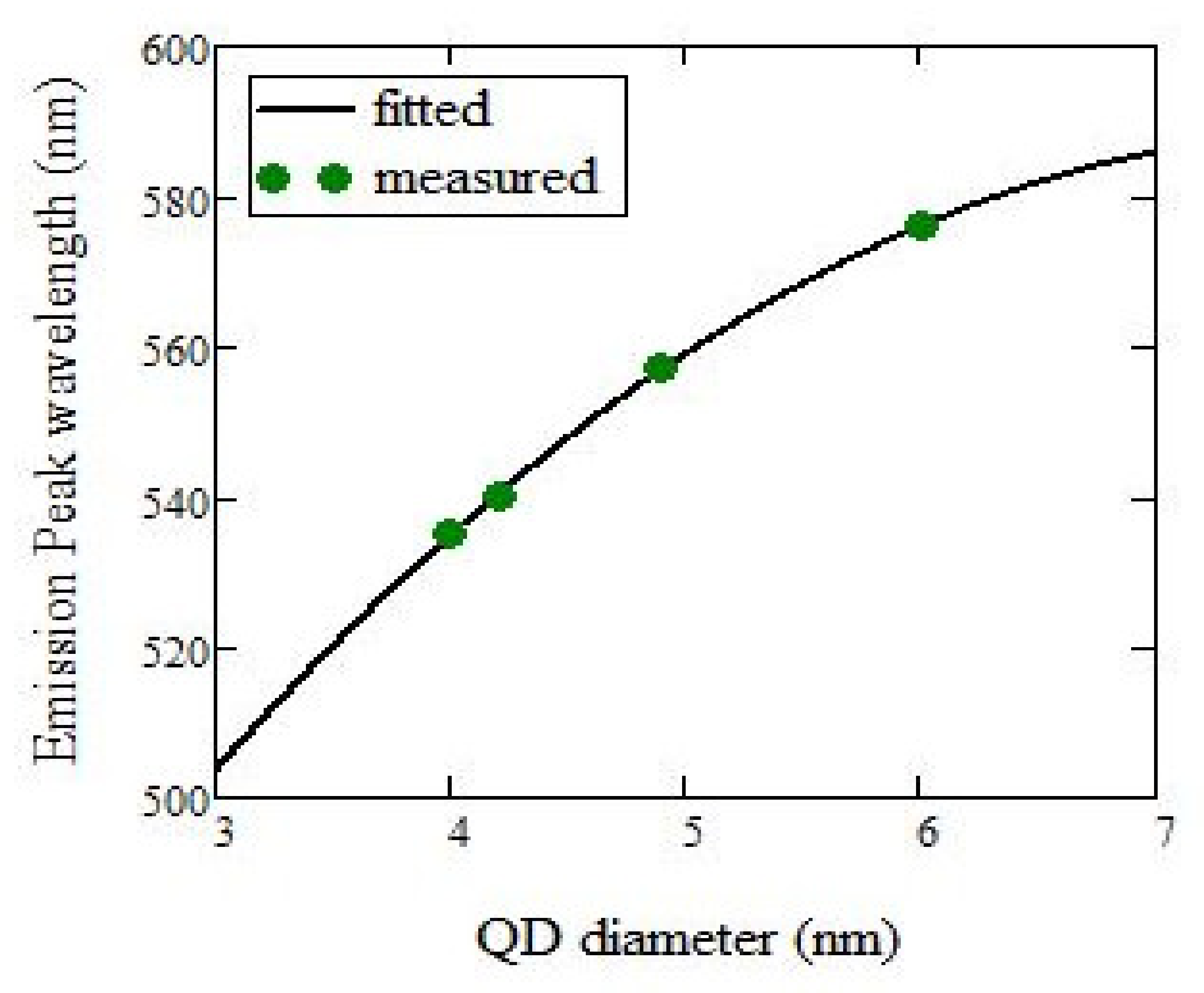
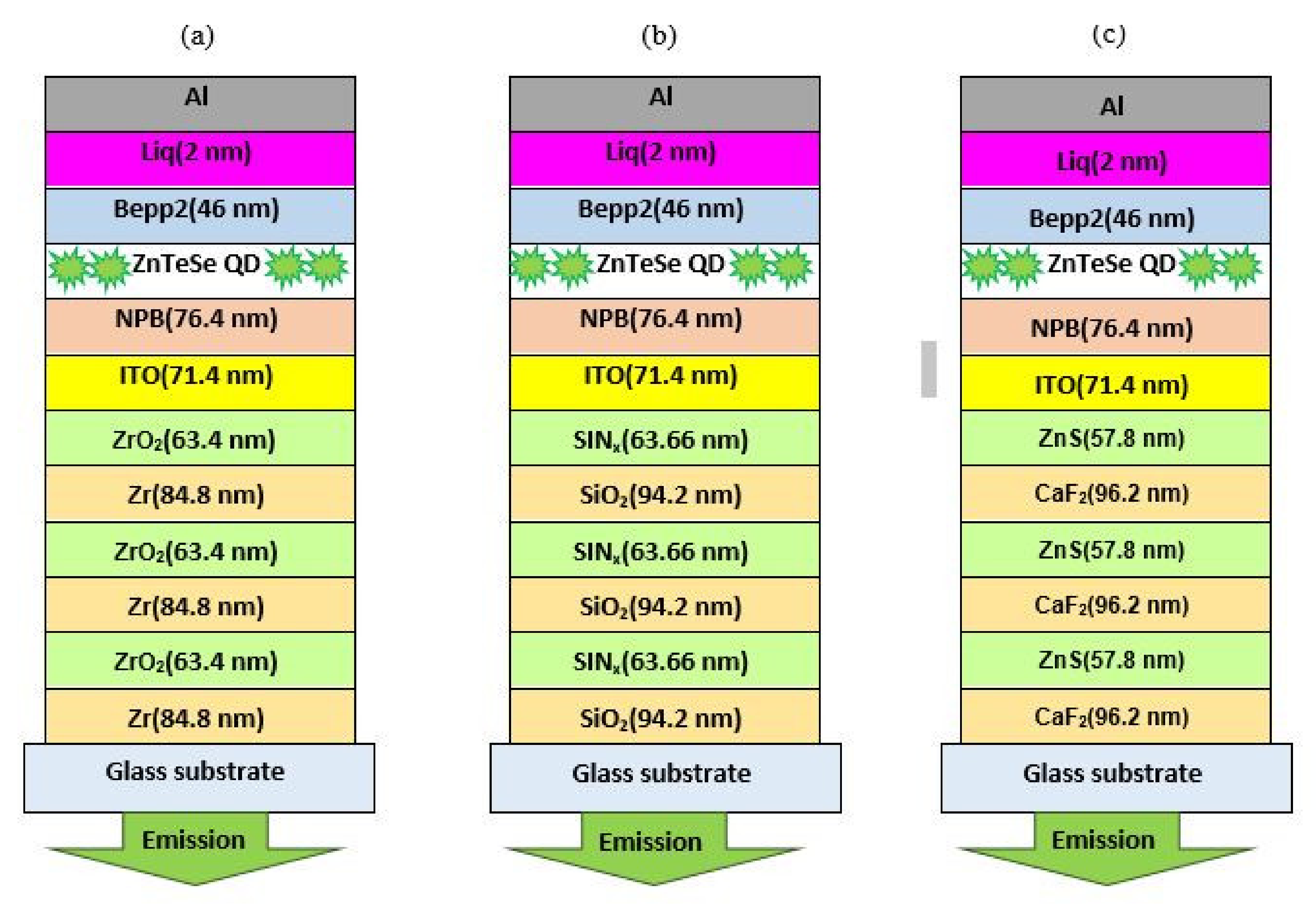

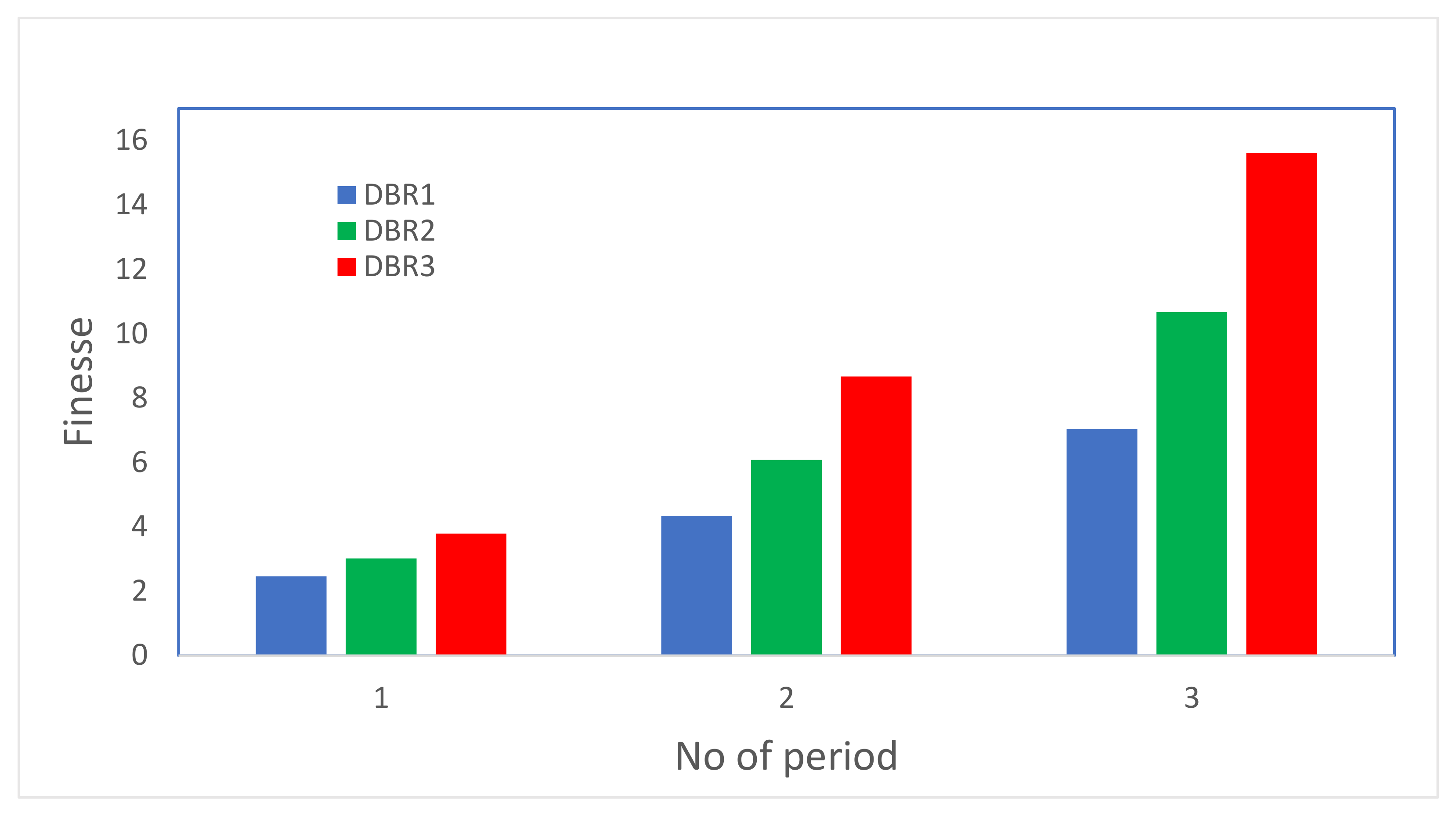

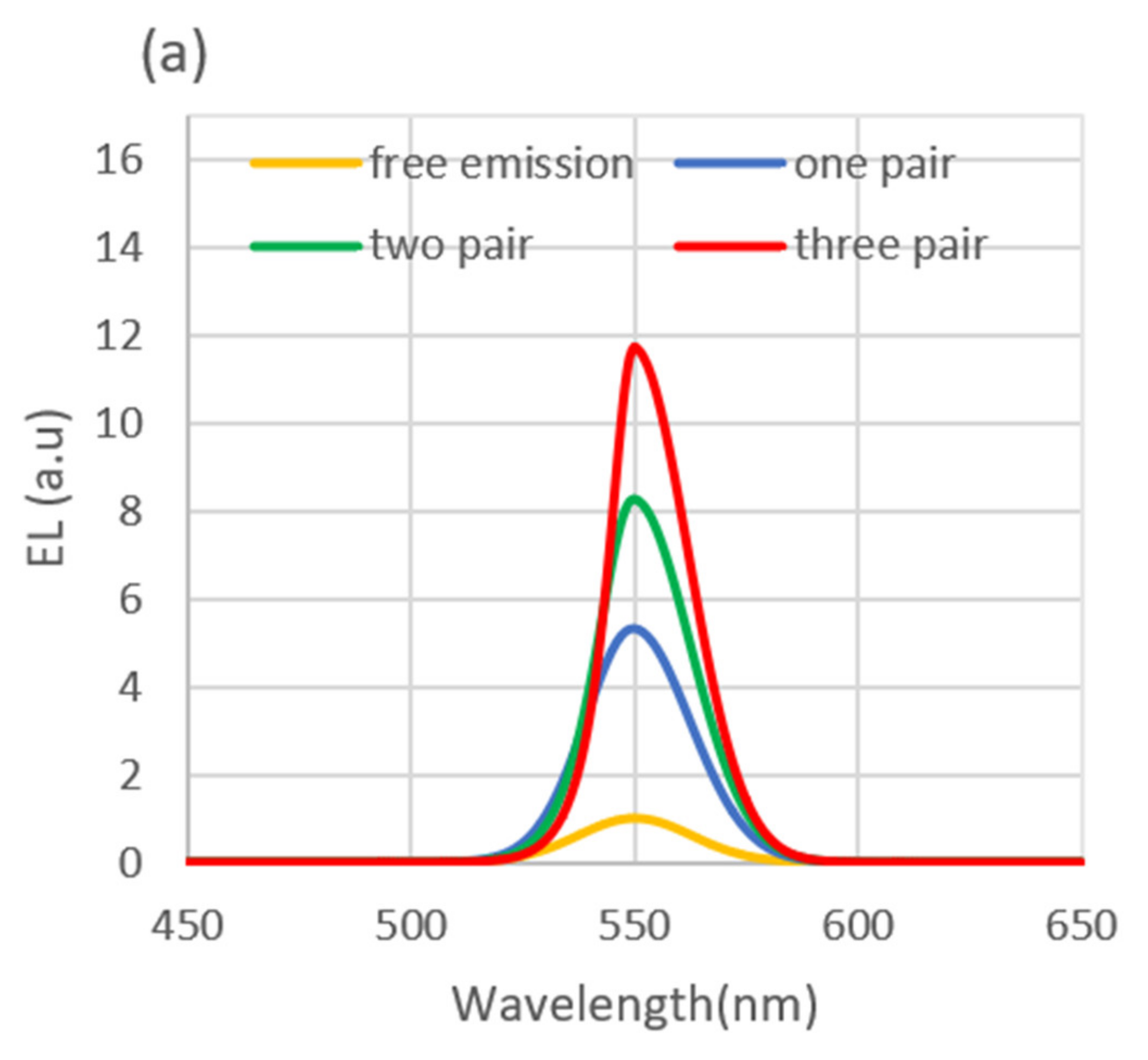
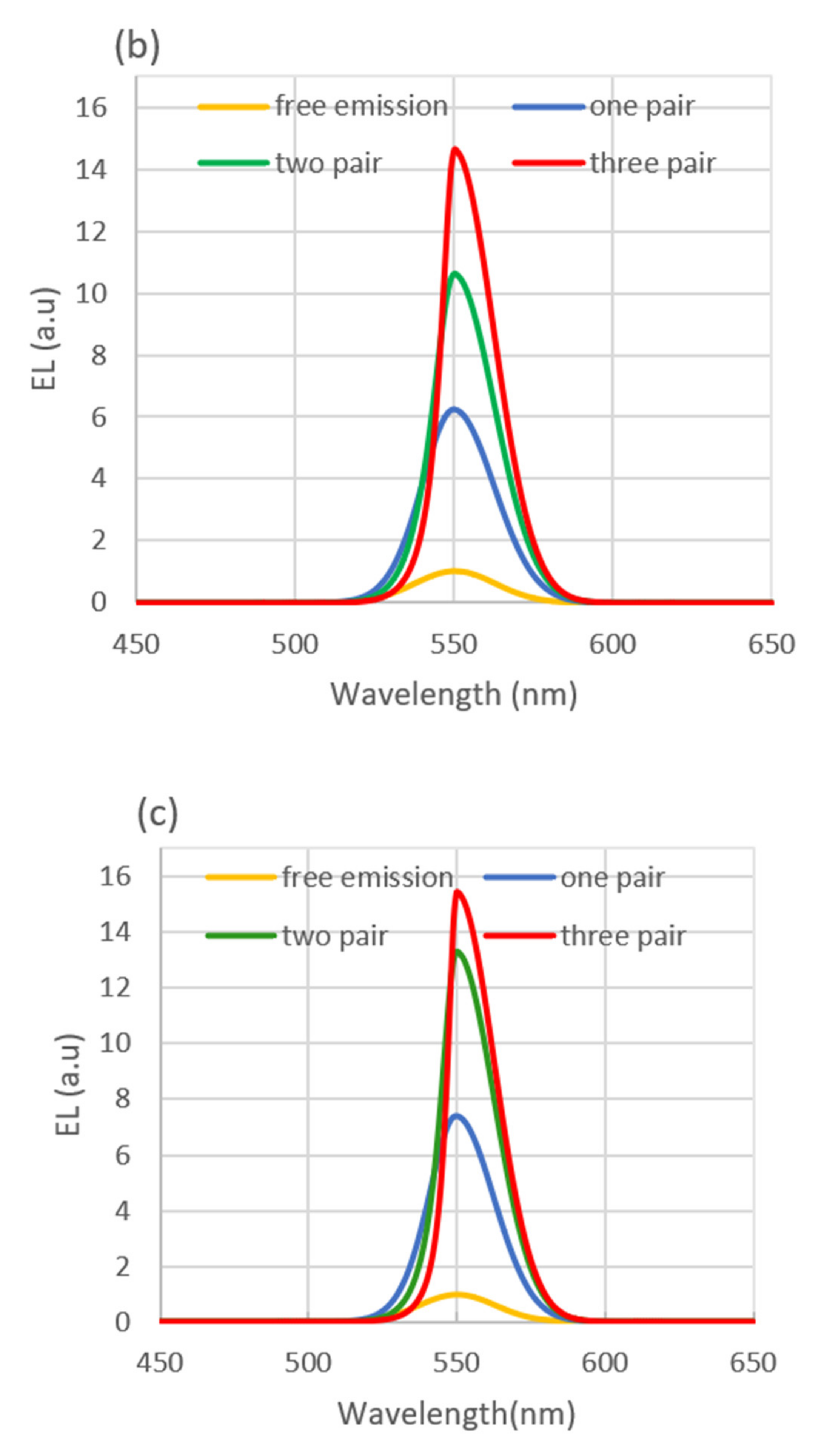
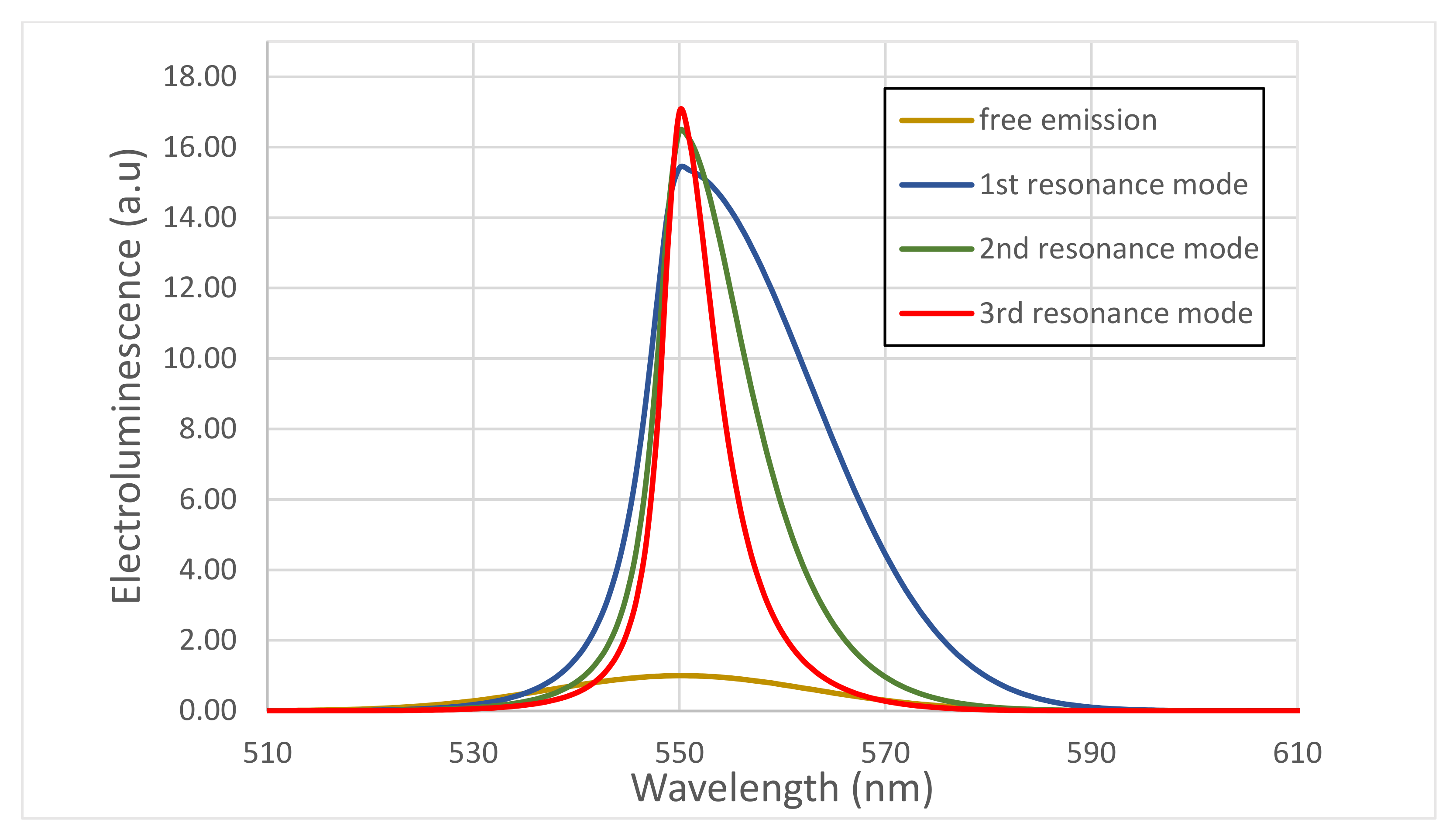
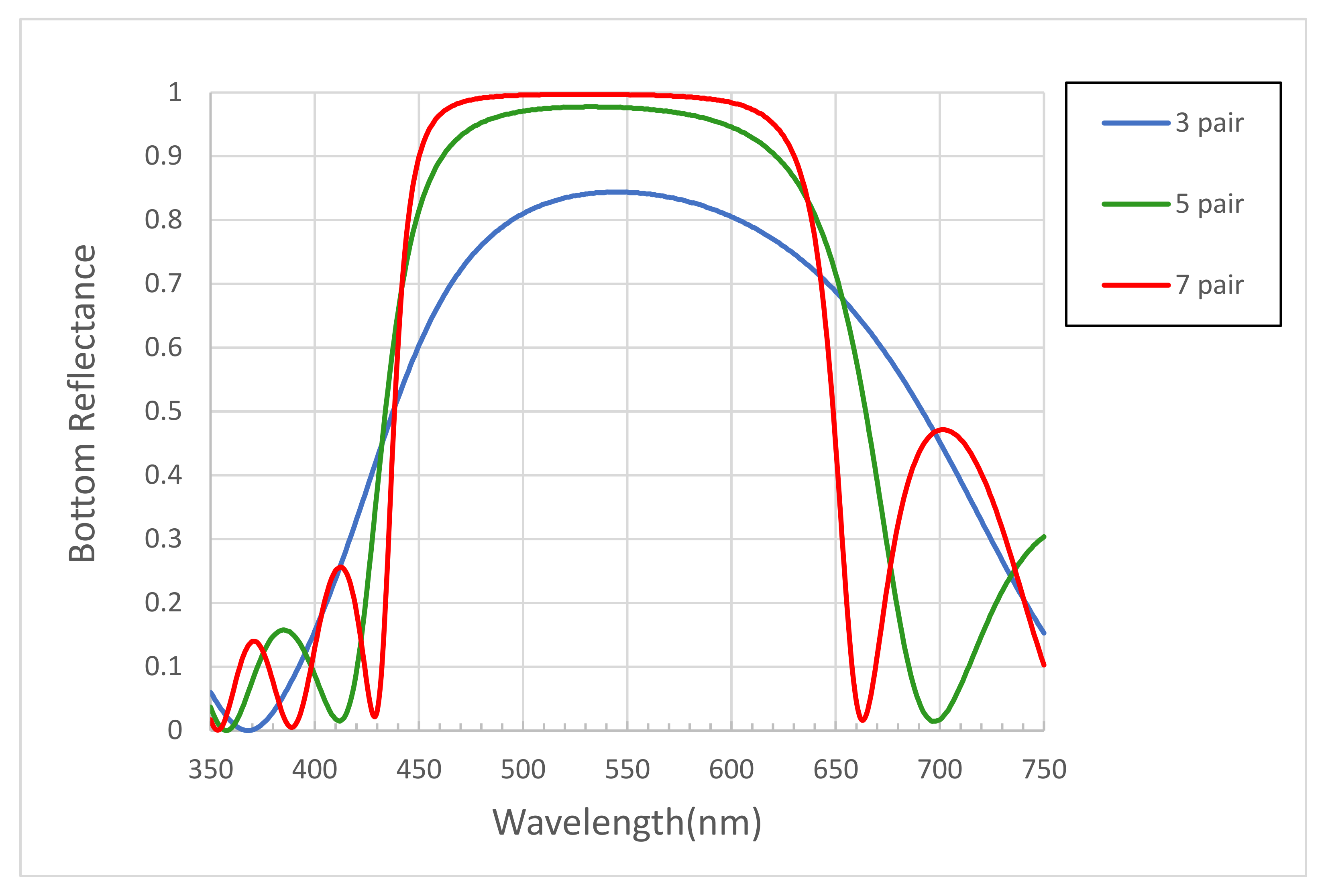
| Material | Zr | ZrO2 | SiO2 | SiNx | CaF2 | ZnS |
|---|---|---|---|---|---|---|
| Refractive index (n) | 1.62 [21] | 2.17 [40] | 1.46 [41] | 2.16 [42] | 1.43 [20] | 2.38 [20] |
| DBR Design | Index Contrast Δn | No. of Periods (N) | Stop Band Width (nm) | Peak Reflectivity | Finesse | Quality Factor | EL Intensity |
|---|---|---|---|---|---|---|---|
| DBR1 (ZrO2/Zr) | 0.55 | 1 | 101 | 0.336 | 2.461 | 2.459 | 5.319 |
| 2 | 0.550 | 4.338 | 7.637 | 8.261 | |||
| 3 | 0.718 | 7.04 | 20.124 | 11.711 | |||
| DBR2 (SiNx/SiO2) | 0.7 | 1 | 136.008 | 0.412 | 3.018 | 3.701 | 6.228 |
| 2 | 0.67 | 6.077 | 14.965 | 10.601 | |||
| 3 | 0.833 | 10.67 | 46.054 | 14.648 | |||
| DBR3 (ZnS/CaF2) | 0.95 | 1 | 178 | 0.498 | 3.784 | 5.803 | 7.43 |
| 2 | 0.779 | 8.67 | 30.417 | 13.279 | |||
| 3 | 0.914 | 15.613 | 98.816 | 15.409 |
| Cavity Mode | Optical Cavity Length | Cavity Enhancement Factor | Photon Life Time (ns) |
|---|---|---|---|
| 1st | 236 | 15.4 | 8.667 |
| 2nd | 511 | 16.451 | 18.74 |
| 3rd | 786 | 16.997 | 28.82 |
Publisher’s Note: MDPI stays neutral with regard to jurisdictional claims in published maps and institutional affiliations. |
© 2022 by the authors. Licensee MDPI, Basel, Switzerland. This article is an open access article distributed under the terms and conditions of the Creative Commons Attribution (CC BY) license (https://creativecommons.org/licenses/by/4.0/).
Share and Cite
Shaaban, I.E.; Samra, A.S.; Muhammad, S.; Wageh, S. Design of Distributed Bragg Reflectors for Green Light-Emitting Devices Based on Quantum Dots as Emission Layer. Energies 2022, 15, 1237. https://doi.org/10.3390/en15031237
Shaaban IE, Samra AS, Muhammad S, Wageh S. Design of Distributed Bragg Reflectors for Green Light-Emitting Devices Based on Quantum Dots as Emission Layer. Energies. 2022; 15(3):1237. https://doi.org/10.3390/en15031237
Chicago/Turabian StyleShaaban, Iman E., Ahmed S. Samra, Shabbir Muhammad, and Swelm Wageh. 2022. "Design of Distributed Bragg Reflectors for Green Light-Emitting Devices Based on Quantum Dots as Emission Layer" Energies 15, no. 3: 1237. https://doi.org/10.3390/en15031237
APA StyleShaaban, I. E., Samra, A. S., Muhammad, S., & Wageh, S. (2022). Design of Distributed Bragg Reflectors for Green Light-Emitting Devices Based on Quantum Dots as Emission Layer. Energies, 15(3), 1237. https://doi.org/10.3390/en15031237






